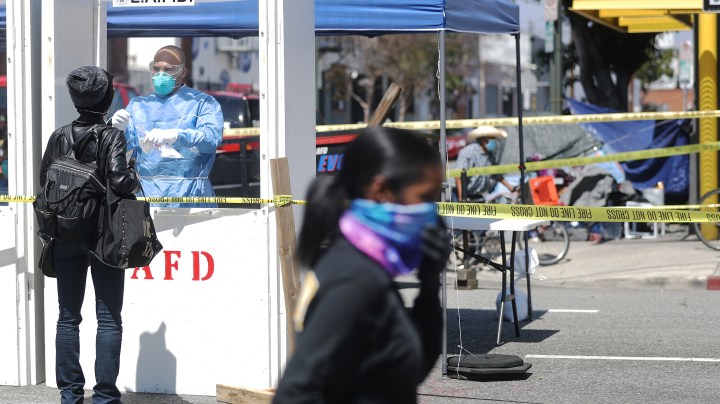How COVID-19 Is Affecting LA County’s Homeless + How You Can Help

A woman is tested for COVID-19 by a member of the Los Angeles Fire Department wearing personal protective equipment (PPE) in Skid Row amidst the coronavirus pandemic on April 21, 2020 in Los Angeles, California. Photo by Mario Tama/Getty Images
Coronavirus itself doesn’t discriminate but the level of care individuals have access to can vary drastically based on race, wealth and other socioeconomic factors. That fact is particularly evident among the homeless community, specifically in Los Angeles, California.
There are approximately 91,000 homeless people in Los Angeles County which has the largest homeless population in the nation for any major metropolitan area. Of those, 39% are Black/African American and 25% are Latino while approximately 55% of those chronically homeless have three or more disabilities. Since the first reported outbreak of COVID-19 among the homeless on March 28, there have since been 43 reported cases in Skid Row, a neighborhood with one of the largest stable homeless populations.
In an effort to better understand how this pandemic is affecting the homeless population in LA County, we reached out to United Way, a non-profit providing housing and services to the local homeless community. We spoke with Chief Operating Officer Oscar Cruz who was born in Guatemala and is a longtime Angeleno who grew up in downtown LA.

People of color make up a large portion of the homeless community in Los Angeles, how do you think COVID-19 will affect the homeless community in the long run and homeless POC in particular?

We know that homelessness disproportionately impacts people of color. African Americans comprise only 8% of our county population but 42% of the homeless population. Latino homelessness has risen in recent years. The health effects of COVID-19 have also fallen disproportionately on people of color. In the long run, we have an obligation to capture the urgency of the pandemic crisis and use it to end the homelessness crisis. The need for social distancing tied to COVID-19 has brought people indoors quicker than at any time in recent memory. We must decide that no one who comes inside should have to go back out on the street, and United Way is working with different levels of government, philanthropy and business to make that a reality. The economic blow of the pandemic has also fallen hard on organizations led by and which serve communities of color, which is why we are taking special efforts to support those organizations with our Pandemic Relief Fund.
How is United Way working to aid the homeless community during this time and what have been some of the challenges you’ve encountered?
We’ve helped bring funds, food, and coordination online so that our shelter system can bring more people inside while helping stay physically farther apart. UWGLA has been working on the long-term goal of ending homelessness for a long time, so we had a lot of connections and knowledge to make a short-term urgent difference. We’re bridging gaps where they come up. For example, COVID-19 threw our food supply into chaos, with people staying at home and restaurants emptying. In that environment, how do you make sure shelters can feed people in need? With 48 hours’ notice, we were able to establish a partnership with DignityHealth and Everytable to provide 9,000 meals to newly stood-up shelters, and we’re continuing to work with the City and LAHSA [LA County Homeless Services Authority] on addressing food issues. Our Home For Good team has forged connections between suppliers across the globe and partners on the ground in LA to get supplies into the hands of front line workers who need them fast. We’re connecting over 100 organizations with supplies and offering mini-grants to 45 organizations. This pandemic has made it harder to access healthcare for underlying chronic conditions, so we are working with our partners to ensure that our homeless neighbors continue to access the care they need as we bring them safely inside.

A pop-up testing site was put up in Skid Row and they found 100 asymptomatic homeless individuals and now the shelters where they are being held are denying entry to control the outbreak, how do you feel about this approach and is there anything else that can be done?
It was clear from the beginning that there would be a need to isolate people carrying COVID-19 for their health and for the health of others. Those health concerns have motivated Project Roomkey, which leases up hotel rooms where people experiencing homelessness can isolate if they have a high risk from the disease—older people, people with medical conditions. At the same time, the public sector provides quarantine facilities such as trailers so people who are under medical instruction to quarantine can do so. United Way has been proud to assist with these efforts.
How can this moment be used to create a shift/change in the way the city of Los Angeles, in particular, handles homelessness?

We are bringing people inside at unprecedented rates to protect our unsheltered neighbors and preserve public health. Homelessness has been a key issue at the forefront of the minds of Angelenos for some time. In recent years we have collectively passed numerous ballot initiatives like Measure H and HHH [a quarter-cent tax hike to help build units for the homeless] to help our homeless neighbors. United Way’s Everyone In campaign has built countywide support to keep our focus on ending homelessness with homes. We believe that no one who comes inside should go back out. We’re working with City, County and LAHSA and Sacramento to find ways to ultimately connect people who have moved into shelters or hotel rooms to housing.
Is there anything beyond what’s being reported that you would like people to know about how COVID-19 is affecting the homeless?
Please keep in mind how scary this time is for our neighbors experiencing homelessness. The only people outside are people who have nowhere else to go. They’re scared. The few comforts they ordinarily have aren’t available: they can’t charge their phone at restaurants, and many of their places to get food are shut down. Homelessness already takes a terrible toll on health, with people in their 50s showing the health problems of people in their 80s. Many people are afraid and everyone is incredibly vulnerable.

What are some ways locals and non-locals can help?
If anyone would like to help us as we bring and keep our unsheltered neighbors inside, they can contribute to UWGLA’s Pandemic Relief Fund.